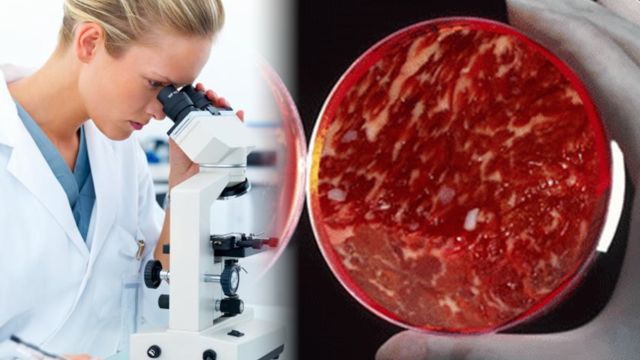Frankenburger is the world’s first test-tube burger and is being served in London.
The burger is made from meat grown in a laboratory, rather than cattle raised in pastures.
And its developers hope it will show how the soaring global demand for protein can be met without the need for vast herds of cattle.
The 5oz Frankenburger, which cost £250,000 ($400,000) to produce, is made from 3,000 tiny strips of meat grown from the stem cells of a cow.
The raw meat is said to be grey with a slippery texture similar to squid or scallop.
It has been created by Professor Mark Post, from the University of Maastricht in Holland.
His research has been funded by an anonymous businessman – who may be the first to try the burger.
Prof. Mark Post told The Independent on Sunday: “Right now, we are using 70 per cent of all our agricultural capacity to grow meat through livestock. You are going to need alternatives. If we don’t do anything meat will become a luxury food and will become very expensive.”
A four-step technique is used to turn stem cells from animal flesh into a burger.
First, the stem cells are stripped from the cow’s muscle.

Next, they are incubated in a nutrient broth until they multiply many times over, creating a sticky tissue with the consistency of an undercooked egg.
This “wasted muscle” is then bulked up through the laboratory equivalent of exercise – it is anchored to Velcro and stretched.
Finally, 3,000 strips of the lab-grown meat are minced, and, along with 200 pieces of lab-grown animal fat, formed into a burger.
The process is still lengthy, as well as expensive, but it could take just six weeks from stem cell to supermarket shelf.
Mark Post’s work is funded by the Dutch government, as well as an anonymous donation of 300,000 euros – but it remains to be seen, however, whether the pioneering development will find favor with a public that likes to think of its chops, steaks and sausages as having their roots in nature, rather than in test-tubes.
He first attempts involved mouse burgers. He then tried to grow pork in a dish, producing strips with the rubbery texture of squid or scallops, before settling on beef.
Mark Post’s burger consists of about 20,000 thin strips of cultured muscle tissue.
The cell-grown burger is produced with materials – including fetal calf serum, which used to grow the cells – that will eventually be replaced by materials not originating from animals, the New York Times reported.
In-vitro meat or cultured meat is an animal flesh product that has never been part of a complete, living animal, and is quite different from imitation meat or meat substitutes, which are vegetarian foods made from vegetable proteins like soy.
Scientists say that it is possible the meat will be sold to the public within ten years.
It also reduces the amount of feed, water and fuel needed to produce beef.
Every kilo of meat requires 10 kilos of plant feed and oil, but cultured meat would only need two.
According to the Food and Agricultural Organization we will be eating twice as much meat as we do now by 2050.
Prof. Mark Post added: “It comes down to the fact that animals are very inefficient at converting vegetable protein into animal protein. This helps drive up the cost of meat.”
It is thought that the new form of meat could be acceptable to vegetarians, and animal rights organizations have already given their approval.
PETA spokesman Ben Williamson said: “We do support lab-grown meat if it means fewer animals are eaten. Anything that reduces the suffering of animals would be welcome.”
PETA also runs a competition offering a $1 million prize for the person who invents an artificial form of chicken meat.
Oxford university scientists said in 2011 that cultured beef would need 45% less energy that natural beef.
They added that it would require 99% less land than regular livestock and produce between 78 and 95% less greenhouse gas.
But, the difficulty may be persuading the public to eat an artificial product.
Prof. Mark Post said that it is possible to add fatty tissue and nutrients to it, changing the taste and making it more palatable for the public.
[youtube 6D5Cv3tDhmA]
